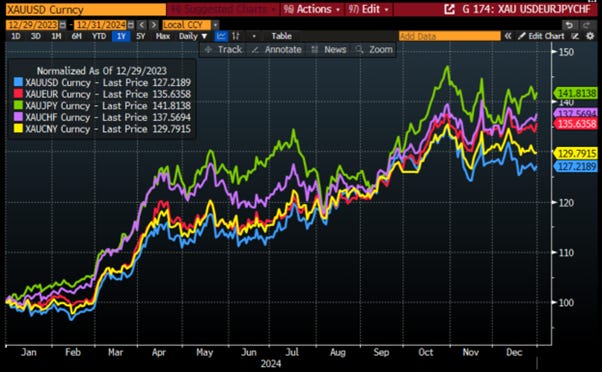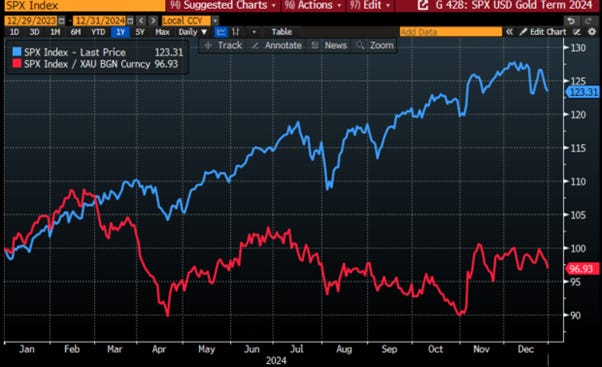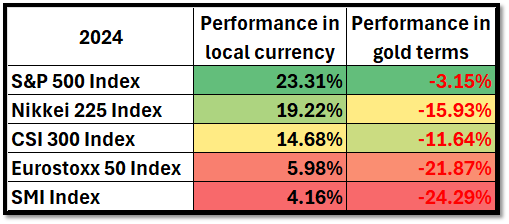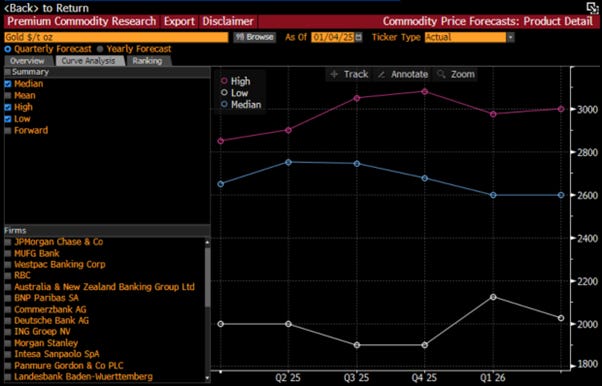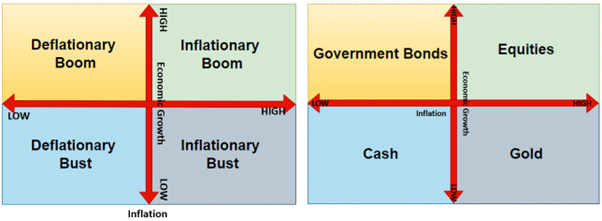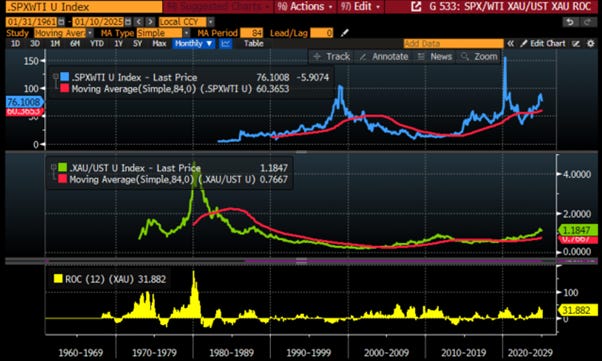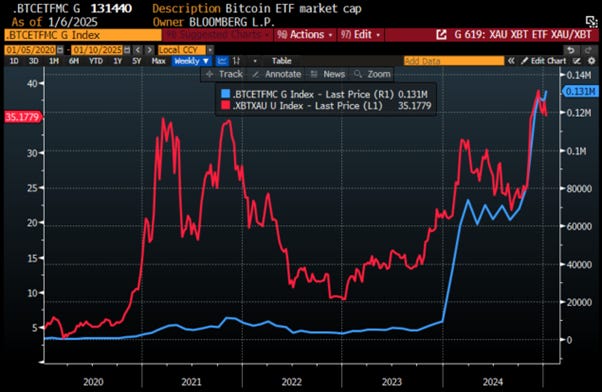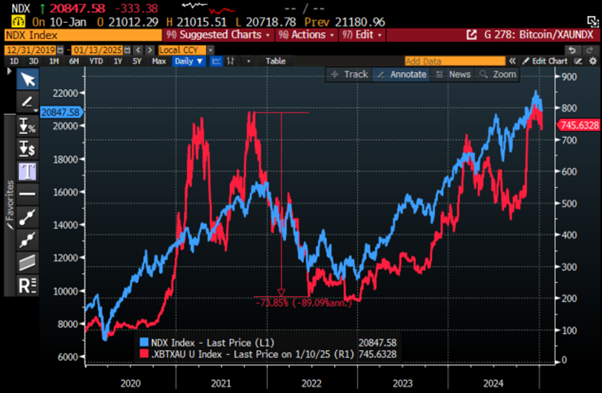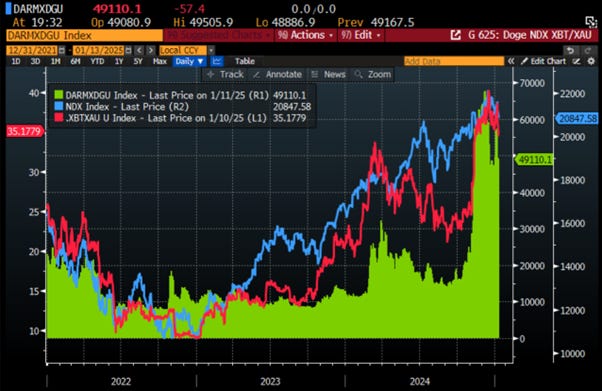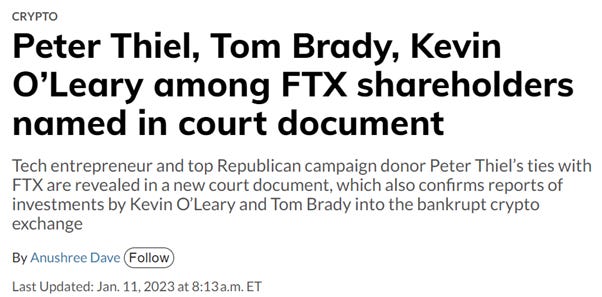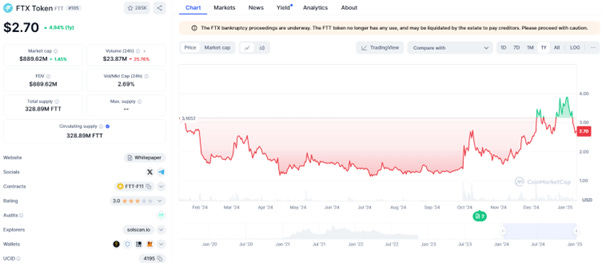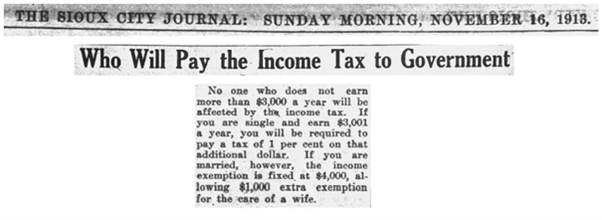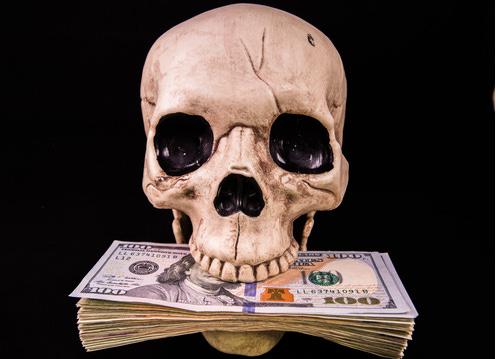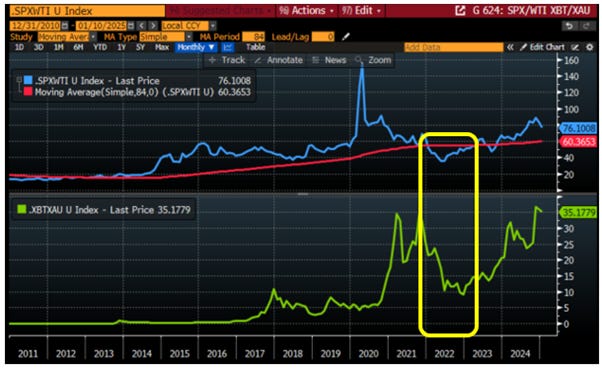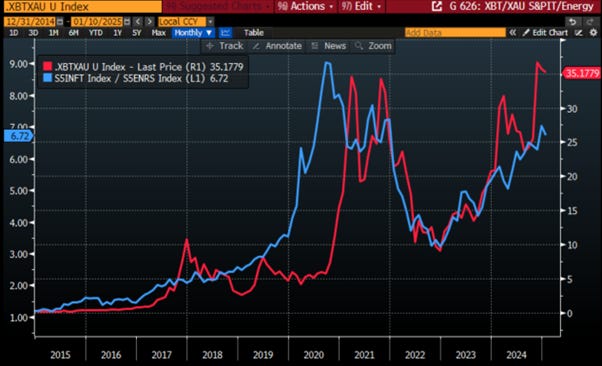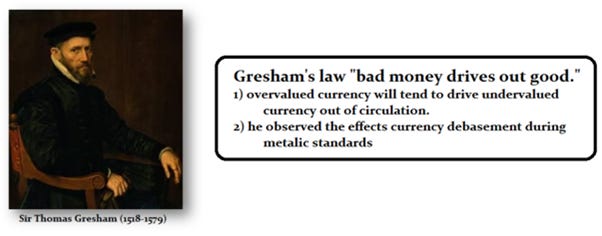GoldenEye
With 2024 in the history books, it’s time to look ahead and consider what the future holds for gold, an asset some market commentators still dismiss as a ‘barbaric relic.’ However, for those who have studied the business cycle and understand how to allocate portfolios using the Permanent Portfolio approach, gold proves to be not only a hedge against wars and reckless government policies but also a safeguard against the stagflationary effects of trade conflicts. Notably, the performance of gold in major currencies outside the USD, such as the JPY, CHF, EUR, and CNY, during 2024 reveals even stronger returns in these currencies compared to its performance in USD.
2024 Performance of Physical Gold in USD (blue line); EUR (red line); JPY (green line); CNY (yellow line); CHF (purple line) (rebased at 100 as of December29th, 2023).
The final month of 2024 saw two of the world’s four largest economies, the Eurozone and Japan, transition from an inflationary boom to an inflationary bust, even before any new tariffs were implemented by the 47th U.S. president-elect. For any investor with a basic understanding of the business cycle and the interconnectedness of global economies, this shift should come as no surprise. In 2024, the only asset class among the four pillars of the Permanent Portfolio that provides a hedge against wars, reckless government policies, and an inflationary bust—physical gold—outperformed the S&P 500 index, even as the U.S. economy remained in an inflationary boom.
2024 Performance of S&P 500 index in USD (blue line); Performance of S&P 500 index in Gold terms (red line) (rebased at 100 as of December 29th, 2023).
Much like U.S. investors, European, Japanese, Swiss, and Chinese investors in 2024 were enticed by the effects of monetary illusion. Historically, this illusion has created the mirage of steady performance in their equity markets when measured in fiat currency terms, while in gold terms, these performances have been negative.
As 2025 begins, the past years of geopolitical tensions, wars, USD weaponization, and central bank gold buying have reinforced gold's appeal against rivals like US equities and Bitcoin despite remaining hated by Wall Street and its parrots. Indeed, consensus forecasts suggest gold will peak at $2,750 in Q2 2025, with estimates ranging from $1,900 to $3,080, Wall Street’s track record in predicting gold prices, like other financial assets, remains poor. Most bankers fail to grasp gold’s role as a hedge against financial system collapse, overlooking growing risks in government bonds and the looming threat of a sovereign debt crisis triggering a banking crisis first in countries like Japan and France but ultimately reaching the US shores as the world remain undoubtedly interconnected.
Rather than attempting to predict gold’s price in 2025 and beyond, savvy investors who understand the business cycle and its impact on the four pillars of the Browne Permanent Portfolio recognize that, in an inflationary environment, portfolios should overweight properties (e.g., stocks and real estate) and underweight contracts (e.g., cash and bonds). These same investors know that when a country transitions from an inflationary boom to an inflationary bust, gold should be favoured over stocks, and energy producers should be favoured over energy consumers. While some investors rely on propagandistic government data to determine a country’s phase in the business cycle, the reality is that market indicators, such as the Equity Market to Oil Ratio and the Gold to Bond Index Ratio, relative to their respective 7-year moving averages, provide a more accurate gauge of a country’s economic cycle and allow for more informed portfolio positioning.
The same investors understand that a country's equity market performance in gold terms, relative to its 7-year moving average, is a key leading indicator of transitions between economic booms and busts. In the U.S., the S&P 500 to Gold ratio just broke below its 7-year average as of January 10th, 2025, confirming its ‘pre-US presidential decline’ signals that a shift from economic boom to bust may be coming sooner rather than most Wall Street analysts are keen to acknowledge. With tariffs adding to the inflationary pressures that have persisted since the start of the decade, there is little indication that the US will exit its inflationary phase soon, suggesting that gold's 12-month returns are poised to strengthen in the year ahead like in did in the 1970s.
Upper Panel: S&P 500 to Oil Ratio (blue line); 84-months Moving Average of S&P 500 to Oil Ratio (red line); Middle Panel: Gold to Bloomberg US Treasury Index (yellow line); 84-monhts Moving Average of Gold to Bloomberg US Treasury Index (red line); Lower Panel: 12-months Rate of Change of Gold price in USD (yellow histogram).
While physical gold outperformed the S&P 500 in 2024, American investors, heavily influenced by Wall Street and its influencing parrots, as well as ETF investing, showed disdain for the shiny metal while favouring the politically driven, fairy-tale narratives surrounding Bitcoin, the miscalled digital version of gold. Indeed, while the total AUM of Physical Gold ETFs listed in the U.S. saw net outflows throughout the year, the total AUM of newly listed Bitcoin ETFs reached over $120 billion. As YOLO investors flocked to Bitcoin ETFs, the Bitcoin to Gold ratio remained stuck near its 2021 peak, signalling a potential turning point ahead.
Total AUM of listed Bitcoin ETFs (blue line); Bitcoin to Gold Ratio (red line).
Savvy investors, not swayed by the misleading narratives propagated by Wall Street, have long understood that Bitcoin is little more than a money laundering tool designed to cater to the speculative interests of YOLO investors. As Bitcoin is merely another vehicle for ‘risk-on’ exposure, rather than an antifragile asset, it comes as no surprise that the Bitcoin-to-Gold ratio peaked on December 17th, 2024, the same day as the Nasdaq. A similar peak occurred in November 2021, just weeks before a 45% correction in the Nasdaq over the following 12 months while the Bitcoin to Gold ratio plummeted by more than 70% over the same period.
Nasdaq 100 index (blue line); Bitcoin to Gold ratio (red line).
For those not yet convinced of the ‘MEME’ characteristics rather than the antifragile nature of cryptocurrencies, a look at Dogecoin (not to be confused with the Department of Government Efficiency led by the modern American version of Rasputin), originally created in 2013 as a joke based on the popular "DOGE" meme, reveals that, unlike Bitcoin, it has officially stated that it has an unlimited supply. This undermines the belief in cryptocurrency's scarcity and value retention. While having no technological utility like Ether, Dogecoin's market capitalization has peaked in sync with the Nasdaq index and the Bitcoin-to-Gold ratio. This should be enough to convince any YOLO investors that cryptocurrencies, whatever they are, are NEITHER ANTIFRAGILE NOR A STORE OF VALUE, but rather speculative tools created for money laundering and financing illegal activities across the world.
Nasdaq 100 index (blue line); Bitcoin to Gold ratio (red line); DOGE Coin Market Capitalization (green histogram).
Cryptocurrencies are not only highly volatile but have also been linked to money laundering, terrorism financing, and financial scandals. The most notable recent case, FTX, involved a crypto exchange, led by a so-called Silicon Valley genius which even managed to raise money from leading sovereign wealth funds such as Temasek and famous supposedly legendary investors such Peter Thiel and Paul Tudor Jones among others.
To make a long story short, Sam Bankman-Fried founded Alameda Research and FTX in 2019, but their close ties led to the misuse of customer funds. In November 2022, a report on Alameda’s FTT holdings triggered a liquidity crisis, exposing an $8 billion shortfall and resulting in FTX’s bankruptcy. The collapse, labelled one of the largest financial frauds in U.S. history, devastated crypto markets and contributed to the failure of Signature Bank, which had $110 billion in assets. To describe the current level of insanity of the ‘Crypto Ponzi Scheme’, despite its parent company’s bankruptcy, the FTX Token ($FTT) still has a market cap of almost $900 million, valuing it higher than half the businesses in the Russell 2000.
https://coinmarketcap.com/currencies/ftx-token/
At the end of the day, not only is Bitcoin not providing any hedge against wild fluctuations in high-beta stocks such as the Nasdaq, but its origin remains obscure, as nobody with a modicum of common sense would believe in the fairy-tale story of Satoshi Nakamoto. Those who have done even a minimal amount of research on Bitcoin's origin will point to a white paper written by the NSA in 1996, which describes electronic cash protocols in terms of basic authentication mechanisms.
https://groups.csail.mit.edu/mac/classes/6.805/articles/money/nsamint/nsamint.htm
Indeed, for those who took the time to learn about the blockchain behind Bitcoin and other cryptocurrencies, they understand that a blockchain is a supposedly decentralized digital ledger that securely stores records across a network of computers in a transparent, immutable, and tamper-resistant manner. Each block contains data and is linked to the previous one in a chronological chain. This structure ensures that once data is recorded, it cannot be altered without the consensus of the network, making it highly secure and reliable for applications beyond cryptocurrencies, such as supply chain management, financial transactions, and data tracking.
Unlike gold, which has no counterparty risk and has served as store of value for centuries, Bitcoin was most likely created by those controlling the deep state to pave the way for Central Bank Digital Currencies (CBDCs), a step toward direct taxation and the erosion of liberty. This mirrors the socialist takeover in the early 20th century, where the income tax was introduced under the false promise that only the rich would pay. The goal behind CBDCs is to eliminate paper money, allowing the state to track everything and turn individuals into economic slaves, much like the control seen in communist regimes. Republics, with their facade of representation, ultimately mask the true tyranny of a system that limits individual freedoms and autonomy.
A store of value has been many things across centuries, from seashells and gold to bronze, grain, and sheepskins. Durable stores of value typically possess practical or utilitarian use. In prison, it used to be a pack of cigarettes, which later shifted to a pack of mackerel. Feeling sorry for the YOLO ‘Bitcoin addicts’, but when a store of value depends on the power grid and can be programmable, it will be subject to a bank debanking you. Therefore, it is not a sustainable store of value.
The ease of storage and monetization is often touted by YOLO investors as proof that Bitcoin is the new store of value in the digital age. However, this argument is misleading, as Bitcoin’s functionality depends on reliable access to both electricity and the internet. Indeed, Bitcoin is notorious for its significant energy requirements for mining and transactions. As of December 2023, the global Bitcoin mining industry consumes an estimated 141.2 terawatt-hours (TWh) of electricity annually, more than double its usage a year earlier and comparable to the yearly electricity consumption of Argentina. A single Bitcoin transaction can use as much electricity as a British household does in two months. In this context, it should come as no surprise to anyone with a modicum of understanding of the business cycle that the evolution of the S&P 500-to-Oil ratio relative to its 7-year moving average, the reliable indicator of the U.S. economy transitioning from boom to bust, closely correlates with peaks in the Bitcoin-to-Gold ratio, which peaked in January 2022 and through in October 2023 while the US was experiencing its most recent inflationary bust.
Upper Panel: S&P 500 to Oil ratio (blue line); 84-months Moving Average of the S&P 500 to Oil ratio (red line); Lower Panel: Bitcoin to Gold ratio (Green line).
The reality is that Bitcoin is nothing more than an investment tool created as a leveraged, energy-consuming asset that will underperform gold, just as energy-consuming sectors tend to underperform energy-producing sectors once the US economy shifts from an inflationary boom to an inflationary bust, as occurred between January 2022 and October 2023.
Relative performance of S&P 500 IT index to S&P 500 Energy index (blue line); Bitcoin to Gold ratio (red line).
Sir Thomas Gresham, serving as the English Crown's agent on the Amsterdam Bourse, observed that debased coinage undermined confidence in government debt repayment, as foreign exchange rates were based on metal content rather than economic power. This insight led to Gresham's Law: "bad money drives out good money." When governments assign equal legal value to currencies of differing intrinsic worth, people hoard "good" money with higher value and spend "bad" debased money. This principle highlights the economic behavior of preserving wealth and its broader implications for currency systems and financial stability. In the multipolar world of today where assets have been weaponized, Gresham’s Law implies that anyone with a modicum of common sense would hoard physical gold while spending debased money, including not only USD fiat currency but also cryptocurrencies based on the false belief that they are antifragile assets with no counterparty risk.
Laser Eyes, a meme popular in the Bitcoin community, symbolizes unwavering confidence in Bitcoin's future. It reflects the determination of ‘Bitcoin addicts’, who follow the HODL strategy, and aims to cut through the noise around Bitcoin’s true potential. While some YOLO investors remain captivated by Wall Street’s hype, the reality is that as the US joins other economies like China, the Eurozone, and Japan in an inflationary bust, the focus will shift from Bitcoin’s speculative allure to the enduring power of Gold, transforming the Laser Eye into a Golden Eye. Indeed, in the worst-case scenario of an inflationary bust, gold, not government bonds, remains the antifragile asset to hold. Among equities, investors will need to shift from energy-consuming sectors like IT to energy-producing sectors like oil and gas. This shift will occur in an environment where investors must increasingly prioritize the Return OF Capital over the Return ON Capital.
Read more and discover how to trade it here: https://themacrobutler.substack.com/p/goldeneye
If this report has inspired you to invest in gold and silver, consider Hard Assets Alliance to buy your physical gold:
https://hardassetsalliance.com/?aff=TMB
At The Macro Butler, our mission is to leverage our macro views to provide actionable and investable recommendations to all types of investors. In this regard, we offer two types of portfolios to our paid clients.
The Macro Butler Long/Short Portfolio is a dynamic and trading portfolio designed to invest in individual securities, aligning with our strategic and tactical investment recommendations.
The Macro Butler Strategic Portfolio consists of 20 ETFs (long only) and serves as the foundation for a multi-asset portfolio that reflects our long-term macro views.
Investors interested in obtaining more information about the Macro Butler Long/Short and Strategic portfolios can contact us at info@themacrobutler.com.
Unlock Your Financial Success with the Macro Butler!
Disclaimer
The content provided in this newsletter is for general information purposes only. No information, materials, services, and other content provided in this post constitute solicitation, recommendation, endorsement or any financial, investment, or other advice.
Seek independent professional consultation in the form of legal, financial, and fiscal advice before making any investment decisions.
Always perform your own due diligence.



